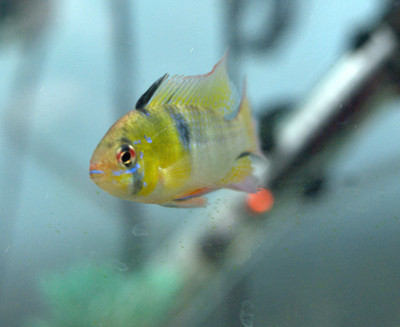German Blue Ram (Mikrogeophagus ramirezi)
Posted by Max Gandara on on 21st May 2025
German Blue Ram (Mikrogeophagus ramirezi) – A Jewel of the Freshwater Aquarium
The German Blue Ram, with its electric hues and peaceful personality, is often called the "jewel cichlid" of the freshwater world. Compact, colorful, and full of personality, this dwarf cichlid brings a flash of brilliance to any well-maintained aquarium.
Whether you’re building a stunning aquascape or a peaceful community tank, German Blue Rams are a top-tier choice for aquarists who want both beauty and brains.
? Species Overview
-
Scientific Name: Mikrogeophagus ramirezi
-
Common Names: German Blue Ram, Blue Ram, Ram Cichlid
-
Origin: South America (Orinoco River basin)
-
Size: 2–3 inches (5–7.5 cm)
-
Lifespan: 2–4 years (with excellent care)
-
Temperament: Peaceful, but territorial when breeding
-
Difficulty: Moderate (sensitive to water quality)
? Appearance
The German Blue Ram is one of the most vibrant freshwater fish available:
-
Iridescent blue and yellow body
-
Red eyes and orange-tipped fins
-
Black markings near the face and upper body
-
Males typically have longer, more pointed dorsal fins
-
Females often display a rosy belly, especially when ready to breed
Their shimmering scales and gentle personality make them a favorite centerpiece in smaller tanks.
? Tank Requirements
These cichlids are small, but they need a well-kept, stable environment to thrive.
Ideal Setup:
-
Tank Size: 20 gallons minimum (especially for a pair)
-
Substrate: Fine sand or smooth gravel
-
Decor: Driftwood, rocks, live plants, hiding spots (caves, pots)
-
Filtration: Gentle; they dislike strong currents
-
Lighting: Moderate – enhances their color but avoid harsh brightness
? Water Parameters
German Blue Rams are sensitive to water quality, so stability is key.
-
Temperature: 78–85°F (25–29°C) – warm water is essential
-
pH: 5.5–7.0 (slightly acidic)
-
Hardness: Soft to moderately hard (1–10 dGH)
-
Ammonia/Nitrite: 0 ppm — even small spikes can be fatal
-
Nitrates: < 20 ppm
Regular testing and weekly water changes are crucial for long-term health.
? Diet & Feeding
These rams are omnivores with a preference for high-protein foods.
Feeding Tips:
-
High-quality micro pellets or cichlid pellets
-
Frozen or live foods: bloodworms, brine shrimp, daphnia
-
Occasional treats: crushed flakes, spirulina, tubifex worms
Feed small amounts 1–2 times daily. Uneaten food should be removed to prevent water fouling.
? Behavior & Tankmates
German Blue Rams are peaceful dwarf cichlids—a rarity in the cichlid world.
Good Tankmates:
-
Tetras (Rummy Nose, Ember, Cardinal)
-
Corydoras
-
Apistos (with caution)
-
Gouramis
-
Livebearers (like mollies and platies)
-
Peaceful dwarf shrimp (risk of predation on babies)
Avoid aggressive or fin-nipping fish and large, boisterous species.
? Breeding German Blue Rams
These rams can be bred in home aquariums but require stable conditions and patience.
Breeding Notes:
-
Best kept as bonded pairs
-
Condition with live/frozen food
-
Spawning site: flat rock or plant leaf
-
Females lay 150–300 eggs, which hatch in 2–3 days
-
Parents guard the eggs and fry – remove if they show aggression or abandon care
-
Fry can be fed infusoria, then baby brine shrimp
Raising fry successfully requires pristine water and a dedicated setup.
⚠️ Common Issues
-
Short lifespan if kept in poor conditions or overbred stock
-
Stress-related illness if water is too cold or unstable
-
Ich and internal parasites can occur if new fish aren’t quarantined
-
Over-filtration or strong current can stress them
Care Tips:
-
Always acclimate slowly
-
Keep tank quiet and free of overly aggressive tankmates
-
Use RO water or Indian almond leaves to soften water if needed

